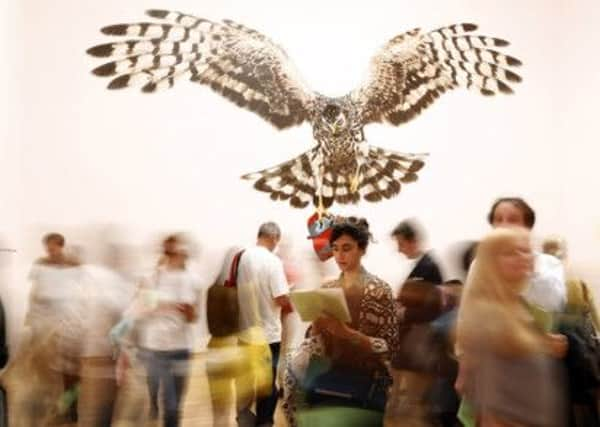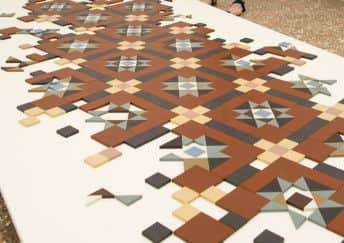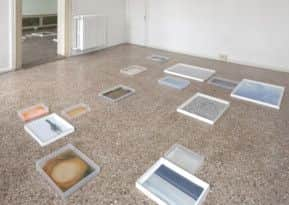Venice Biennale: Scottish artists’ mosaics of life


WHEN artist Corin Sworn visited Venice she was, like many visitors, struck by the beautiful mosaics of the city’s churches. When, as part of her show at Scotland’s presentation at the Venice Biennale, she decided to make a film in Peru, retracing the steps of her anthropologist father, she was equally impressed with the local tiles.
It was only on returning to her own Glasgow flat that she really noticed the Victorian encaustic tiled floor that she crossed every day. But Sworn’s recreation of those tiles, laid out on a low plinth in the 15th-century Palazzo Pisani that is home to the Scottish exhibition, is not straightforward. Look at it for a few minutes and the familiar pattern begins to dissolve at the edges or repeat with irregularity. Memory is not always reliable, reproduction can be misleading: objects are not always what they seem.
Advertisement
Hide AdA sense of subjectivity is key to the three artists presented by Scotland+ Venice this year. It is now a decade since Scotland first hit the canals of Venice, running with artists Claire Barclay, Jim Lambie and Simon Starling. This year’s show, with Sworn, Hayley Tompkins and Duncan Campbell, is the sixth that the partnership between Creative Scotland and the British Council (Scotland) has created. Wales has a project here too. Northern Ireland is absent this year (for financial reasons) but may return.


Scots have shown here since Charles Rennie Mackintosh. The structure and politics of the Biennale are complex. So complex that the Romanians have produced a striking and humorous performance in their empty national pavilion in the Biennale park known as the Giardini, restaging its highlights and scandals, its politics and power plays. The Giardini, with its permanent pavilions, represents great powers and old world politics, but the nuance is such that this year France and Germany have swapped buildings.
You can get dizzied by all of this or you can just get down to it. Glasgow’s Common Guild, in the person of director Katrina Brown and curator Kitty Anderson, who have selected and curated the Scottish project, have done the latter.
In her film The Foxes, Sworn and her father return to the rural village where he witnessed peasant rebellion and the land retrieval movement of rural farmers, but everything has changed. Sworn has never visited before but she feels she has, having seen her father’s slide shows. Events are interpreted differently by the survivors. A striking local horseman is now a fruit seller on a city street. The Foxes is elegant, sad and understated.
Venice has seen its fair share of pirates, but none so delicate as artist Hayley Tompkins. When she describes herself as pirating material, Tompkins means she takes what is already out there. She is a painter I have admired for many years but her work at Venice has taken her to new ground. On the floor in two room-sized arrangements are sequences of framed photographs and paintings made by pouring acrylic into plastic trays. The photographic images, all stock material, include oranges, figs, sailing boats and a combine harvester. Next to them Tompkins’ poured paint asserts her own presence and her own hand. The fluid has evaporated, leaving scorched landscapes of colour next to bottles of pigment-filled water. In the next room the terrazzo flooring is echoed in images of pebbles. Both analogue and digital, assertive and evasive, Tompkins’ installation is above all beautiful.


Film-maker Duncan Campbell begins with a showing of Statues Also Die, a 1953 film on African tribal art made by Chris Marker and Alain Resnais that exposed the deep fractures created by colonialism. Its anti-racist sentiment meant it was banned for a few years then shown with the commentary censored.
Advertisement
Hide AdBut the film is also a flawed period piece and Campbell’s own film, It For Other, is a commentary on that which flows into something else altogether: a rumination of images and their history, objects and their secret lives. You stand face to face with an African mask until a cabinet door swings and you realise it is under glass. In a sequence that playfully employs the Campbell’s soup can, so beloved of Andy Warhol, you begin to sense something else at play. Campbell himself doesn’t feature, but I wonder if it is the closest to a self-portrait that he might ever make. It is about the difficulties of identity in a commodity age.
At the heart of the film, unexpectedly, lies a dance sequence, a monochrome delight choreographed by the legendary Michael Clark. Black-clad figures twirl on a blank set. Viewed from above, their bodies help spell out words, diagrams and ideas. A Marxist analysis of the division of labour presented as a pared down Ziegfeld Follies, Campbell’s film feels like it hasn’t quite resolved its edit, but it is also exhilarating and gives such endless food for thought that it should turn out to have real staying power.
Advertisement
Hide AdIn the context of the wider Biennale, Campbell’s film absolutely sings. Venice is constructed around a sequence of National Pavilions, “collateral events” and curated shows that take up the vast medieval dockyard known as the Arsenale and the central pavilion in the Giardini. Curator Massimiliano Gioni’s show The Encyclopedic Palace is an evocation of grand imagined projects, libraries and archives, museums and collections. It includes a haunting installation by Glasgow’s Cathy Wilkes of crouched figures, a drinking man with his back to two children. At the centre of the show is the Red Book, the extraordinary illuminated manuscript that Carl Jung kept (and kept secret) to mark his dreams and nightmares.
Woven into this are images that resonate: Ed Atkins’ film shows the collection of modernist paintings and tribal artefacts that decorated the Surrealist André Breton’s Paris apartment. What does it mean when all these objects come unmoored from their roots? Campbell’s film asks us about what happens when the things we make and touch become separated from us, when we lose grasp of history as it is forced into clear narratives or boiled down to single images.
Control is an issue here, as it is in the messy global politics that erupt from time to time. The Chinese Artist Ai Weiwei can’t be here. But in a quiet church he has placed six miniature sculptural dioramas that tell of his 81 days imprisoned by the Chinese state in an unknown location. He is interrogated, supervised, monitored even as he sleeps.
There are politics too in Jeremy Deller’s wonderful exhibition English Magic for the British Pavilion. It’s like a long cool drink of water or, more precisely, a bracing cup of tea, which he serves in the pavilion. It’s an angry and elegiac confrontation with Britishness, to the soundtrack of a steel band playing Vaughan Williams and David Bowie. He has commissioned a mural in which the ghost of artist and socialist William Morris throws Roman Abramovich’s yacht Luna into the Venice Lagoon. It had parked outside the Giardini, blocked the quayside and cast a long shadow over Venice in 2011.
The rich people haven’t gone away, but this year you sense the artists are taking back the territory. At Palazzo Pisani, Scotland feels like it is part of a number of trends. The thoughtful film essay has replaced the documentary. Women are represented better than I can recall in years. History is yours to handle.
In the Welsh exhibition, The Starry Messenger, artist Bedwyr Williams has a funny, lovely film about a mosaic that comes to life and is smashed to smithereens. At Venice this year, artists struggle to come to terms with the complexity of the world, creating their own magic and building shapes out of fragments and fragments out of shapes. «
Twitter: @moirajeffrey
Scotland+Venice is at Palazzo Pisani. The 55th Venice Biennale runs until 24 November www.labiennale.org, www.scotlandandvenice.com